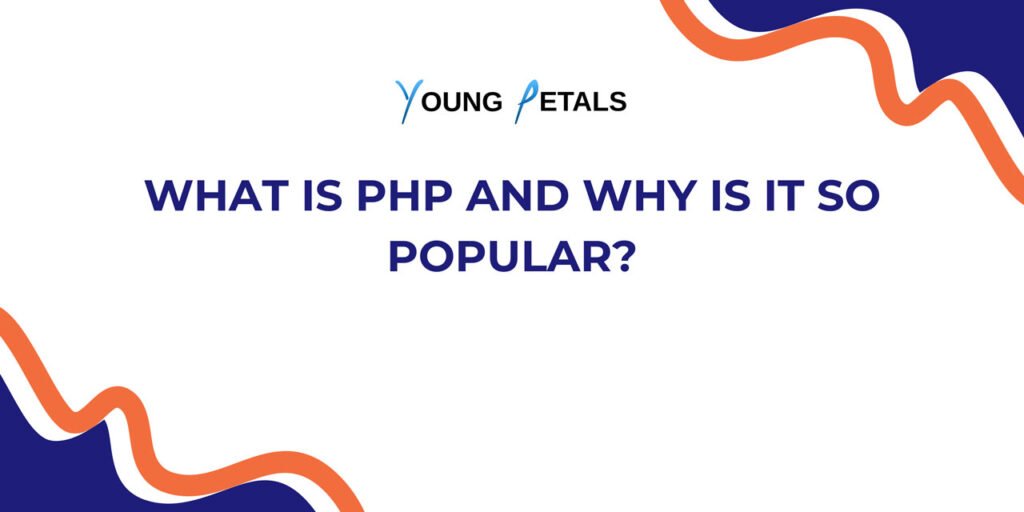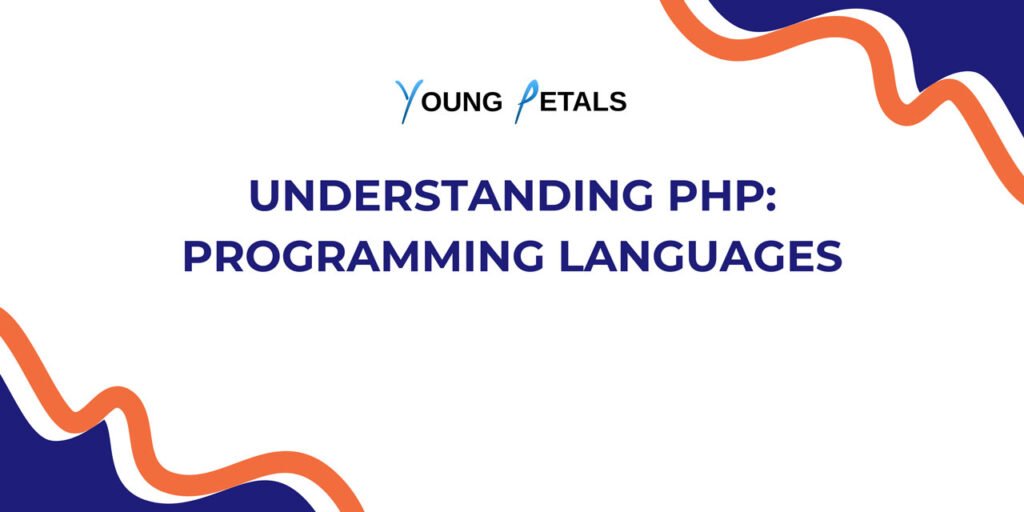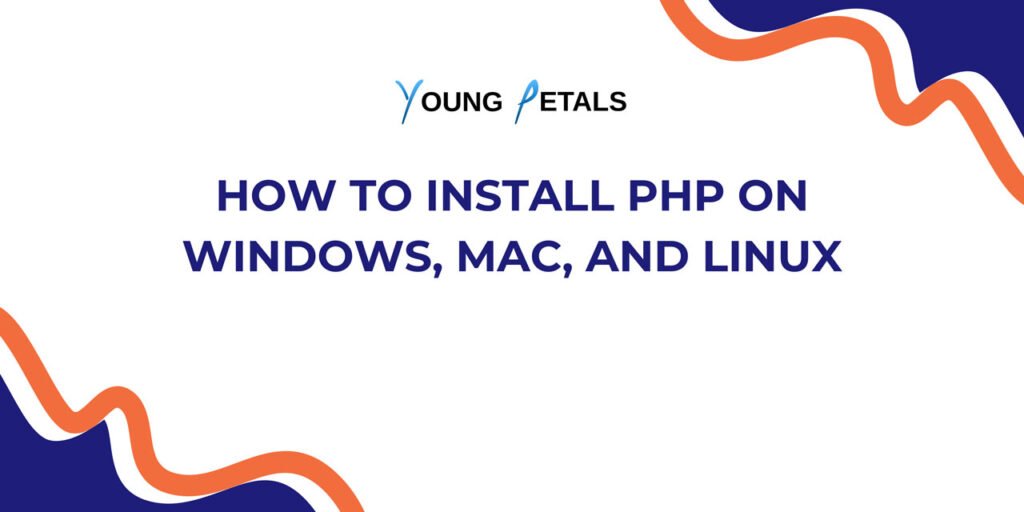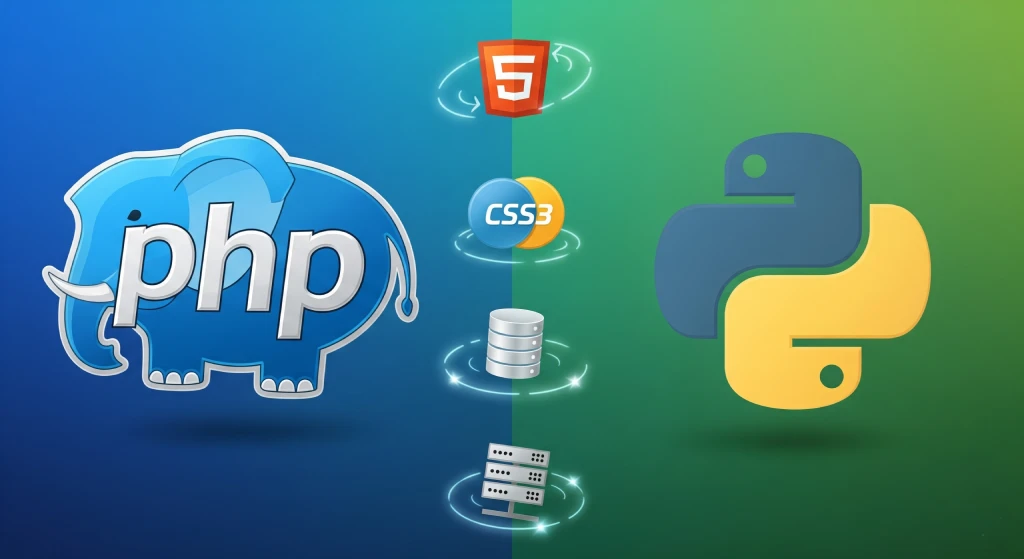
Choosing the right programming language for web development can feel overwhelming, especially when you’re deciding between two powerhouses like PHP and Python. Both languages have carved out significant niches in the web development world, each bringing unique strengths and characteristics that make them suitable for different types of projects.
Understanding the fundamental differences between PHP and Python isn’t just about syntax or performance metrics. It’s about recognizing which tool aligns best with your project requirements, team expertise, and long-term maintenance goals. Let’s explore these languages from multiple angles to help you make an informed decision.
Understanding the Fundamentals
What Makes PHP Unique for Web Development
PHP was born specifically for web development back in 1995, and this heritage shows in every aspect of the language. When Rasmus Lerdorf created PHP, he designed it to solve web-specific problems, making it incredibly intuitive for developers working on web applications.
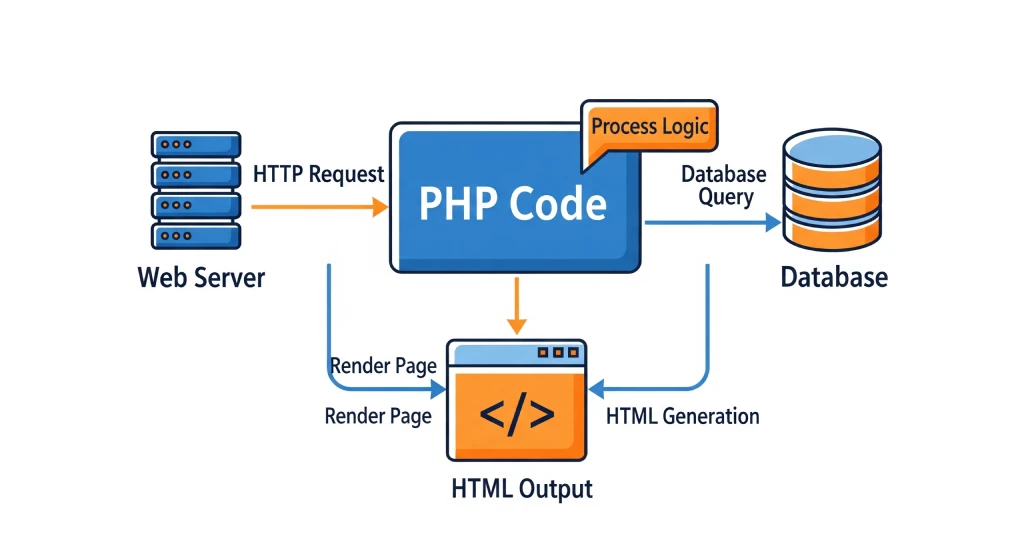
The language operates with a simple yet powerful model. When a user requests a PHP page, the server processes the PHP code and sends HTML back to the browser. This straightforward approach means you can embed PHP directly into HTML, creating dynamic content with minimal setup.
Here’s a basic example that demonstrates PHP’s web-centric nature:
<!DOCTYPE html>
<html>
<head>
<title>Welcome Page</title>
</head>
<body>
<h1>Welcome, <?php echo htmlspecialchars($_GET['name'] ?? 'Guest'); ?>!</h1>
<?php
// Connect to database and fetch user data
$pdo = new PDO('mysql:host=localhost;dbname=website', $username, $password);
$stmt = $pdo->prepare('SELECT * FROM users WHERE active = 1');
$stmt->execute();
$users = $stmt->fetchAll();
?>
<h2>Active Users:</h2>
<ul>
<?php foreach ($users as $user): ?>
<li><?php echo htmlspecialchars($user['name']); ?></li>
<?php endforeach; ?>
</ul>
</body>
</html>
This example shows how PHP seamlessly integrates with HTML, handles user input, connects to databases, and generates dynamic content. The embedded nature of PHP makes it exceptionally straightforward for developers to see immediate results and understand the relationship between their code and the web output.
Python’s Versatile Approach to Web Development
Python takes a different philosophical approach. Rather than being designed specifically for web development, Python was created as a general-purpose programming language that happens to excel at web development through powerful frameworks and libraries.

Python’s strength lies in its clean syntax and the principle that “there should be one obvious way to do it.” This philosophy extends to web development, where frameworks like Django and Flask provide structured approaches to building web applications.
Here’s how you might create a similar functionality using Python with Flask:
from flask import Flask, request, render_template
import sqlite3
from werkzeug.utils import escape
app = Flask(__name__)
def get_active_users():
"""Fetch active users from database"""
conn = sqlite3.connect('website.db')
cursor = conn.cursor()
cursor.execute('SELECT name FROM users WHERE active = 1')
users = cursor.fetchall()
conn.close()
return [user[0] for user in users]
@app.route('/')
def welcome():
# Get name from query parameter, default to 'Guest'
name = request.args.get('name', 'Guest')
users = get_active_users()
# Pass data to template for rendering
return render_template('welcome.html', name=name, users=users)
if __name__ == '__main__':
app.run(debug=True)
And the corresponding HTML template (welcome.html):
<!DOCTYPE html>
<html>
<head>
<title>Welcome Page</title>
</head>
<body>
<h1>Welcome, {{ name|e }}!</h1>
<h2>Active Users:</h2>
<ul>
{% for user in users %}
<li>{{ user|e }}</li>
{% endfor %}
</ul>
</body>
</html>
Notice how Python enforces a cleaner separation between logic and presentation. The business logic lives in Python functions, while the presentation layer is handled by HTML templates. This separation makes larger applications more maintainable and testable.
Performance Deep Dive
PHP Performance Characteristics
PHP has undergone significant performance improvements, particularly with PHP 7 and later versions. The language now uses the Zend Engine, which provides impressive speed improvements for web applications.
PHP’s performance advantages stem from several factors. First, PHP is designed to start quickly and handle individual requests efficiently. Each request typically starts fresh, which means there’s minimal overhead between requests but also means each request needs to bootstrap the application.
Here’s an example of PHP code that demonstrates efficient database handling:
<?php
// Using prepared statements for better performance and security
class UserManager {
private $pdo;
public function __construct($database_url) {
// Connection pooling and persistent connections improve performance
$this->pdo = new PDO($database_url, null, null, [
PDO::ATTR_PERSISTENT => true,
PDO::ATTR_ERRMODE => PDO::ERRMODE_EXCEPTION
]);
}
public function getUsersByStatus($status) {
// Prepared statements are compiled once, executed multiple times
static $stmt = null;
if ($stmt === null) {
$stmt = $this->pdo->prepare('
SELECT id, name, email
FROM users
WHERE status = ?
ORDER BY created_at DESC
LIMIT 100
');
}
$stmt->execute([$status]);
return $stmt->fetchAll(PDO::FETCH_ASSOC);
}
}
// Usage example
$userManager = new UserManager('mysql:host=localhost;dbname=app');
$activeUsers = $userManager->getUsersByStatus('active');
?>
PHP’s strength lies in handling many concurrent requests efficiently, making it excellent for traditional web applications where each page load is a separate request.
Python Performance Considerations
Python’s performance characteristics are different but not necessarily inferior. While Python might be slower in raw execution speed, it often compensates through efficient algorithms, better code organization, and powerful optimization libraries.
import asyncio
import aiohttp
import asyncpg
from typing import List, Dict
class AsyncUserManager:
"""Asynchronous user manager for high-performance applications"""
def __init__(self, database_url: str):
self.database_url = database_url
self.connection_pool = None
async def initialize_pool(self):
"""Initialize database connection pool for better performance"""
self.connection_pool = await asyncpg.create_pool(
self.database_url,
min_size=10,
max_size=20
)
async def get_users_by_status(self, status: str) -> List[Dict]:
"""Fetch users asynchronously for better performance"""
query = """
SELECT id, name, email
FROM users
WHERE status = $1
ORDER BY created_at DESC
LIMIT 100
"""
async with self.connection_pool.acquire() as connection:
rows = await connection.fetch(query, status)
return [dict(row) for row in rows]
# Usage in a web framework like FastAPI
from fastapi import FastAPI
app = FastAPI()
user_manager = AsyncUserManager('postgresql://user:pass@localhost/db')
@app.on_event("startup")
async def startup():
await user_manager.initialize_pool()
@app.get("/users/{status}")
async def get_users(status: str):
return await user_manager.get_users_by_status(status)
This Python example demonstrates how modern Python frameworks handle performance through asynchronous programming, connection pooling, and efficient database interactions. While the individual request might take slightly longer to process, the application can handle many more concurrent requests.
Learning Curve and Developer Experience
Getting Started with PHP
PHP’s learning curve is generally considered gentler for beginners, especially those coming from HTML and basic web development. You can start writing PHP by simply adding PHP tags to existing HTML files.
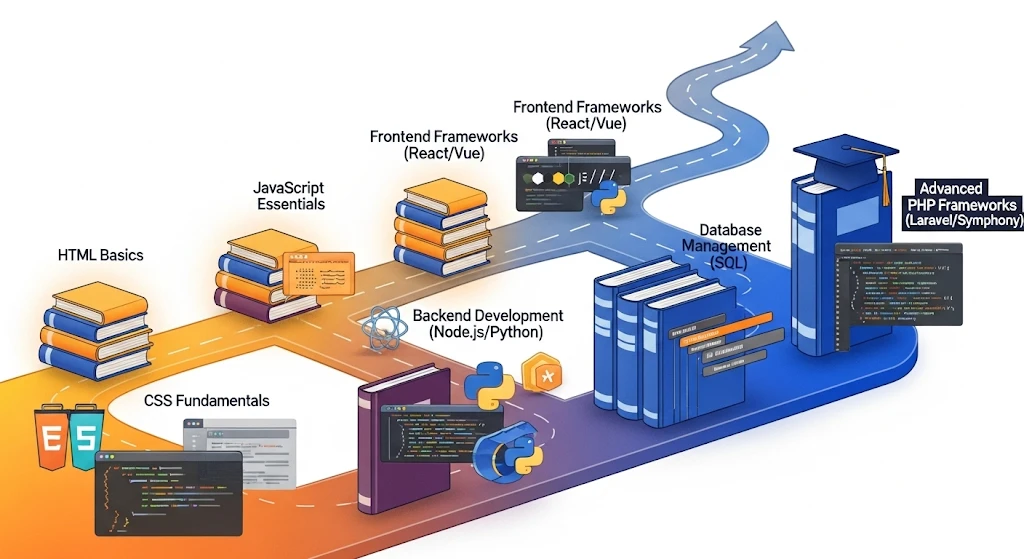
The progression typically follows this path:
Beginning Level: Start by embedding simple PHP in HTML
<!DOCTYPE html>
<html>
<body>
<h1>Today's Date</h1>
<p>Today is <?php echo date('Y-m-d'); ?></p>
<h2>Random Number</h2>
<p>Your lucky number is <?php echo rand(1, 100); ?></p>
</body>
</html>
Intermediate Level: Learn about functions, classes, and database interactions
<?php
class BlogPost {
private $title;
private $content;
private $author;
public function __construct($title, $content, $author) {
$this->title = $title;
$this->content = $content;
$this->author = $author;
}
public function getExcerpt($length = 150) {
return strlen($this->content) > $length
? substr($this->content, 0, $length) . '...'
: $this->content;
}
public function toHTML() {
return sprintf(
'<article><h2>%s</h2><p>%s</p><small>By %s</small></article>',
htmlspecialchars($this->title),
htmlspecialchars($this->getExcerpt()),
htmlspecialchars($this->author)
);
}
}
// Usage
$post = new BlogPost(
'Learning PHP',
'PHP is a great language for web development...',
'Jane Developer'
);
echo $post->toHTML();
?>
Advanced Level: Master frameworks like Laravel or Symfony
Python’s Learning Journey
Python’s learning curve requires more upfront investment in understanding programming concepts, but many developers find the journey more rewarding due to the language’s consistency and elegance.
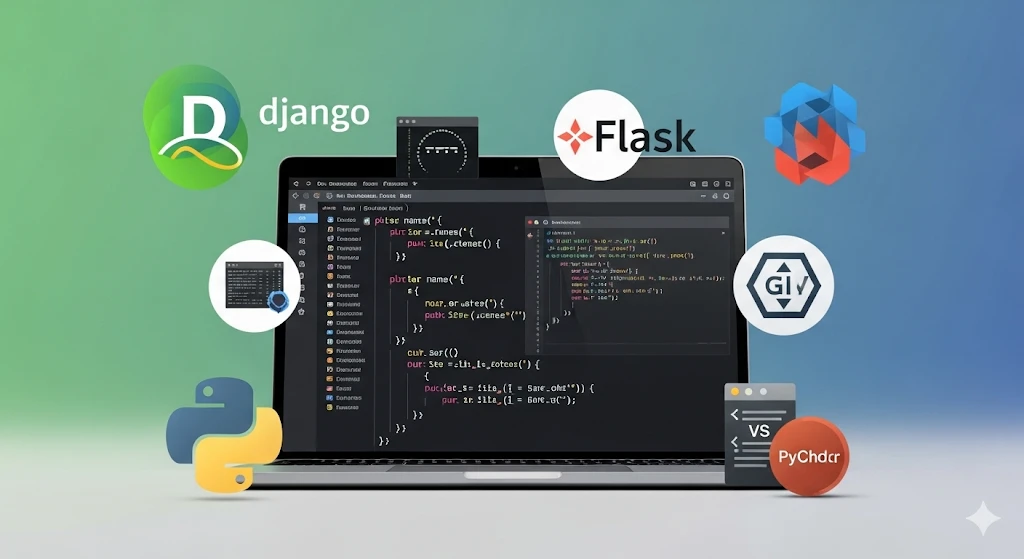
Python web development typically starts with understanding the language fundamentals before diving into web-specific concepts:
Foundation Building: Understanding Python syntax and principles
class BlogPost:
"""A simple blog post class demonstrating Python principles"""
def __init__(self, title: str, content: str, author: str):
self.title = title
self.content = content
self.author = author
self.created_at = datetime.now()
def get_excerpt(self, length: int = 150) -> str:
"""Return a truncated version of the content"""
return (self.content[:length] + '...') if len(self.content) > length else self.content
def to_dict(self) -> dict:
"""Convert post to dictionary for JSON serialization"""
return {
'title': self.title,
'content': self.content,
'author': self.author,
'excerpt': self.get_excerpt(),
'created_at': self.created_at.isoformat()
}
def __str__(self) -> str:
return f"BlogPost('{self.title}' by {self.author})"
# Usage
post = BlogPost(
'Learning Python',
'Python offers elegant solutions for web development...',
'Jane Developer'
)
print(post)
print(post.to_dict())
Web Framework Integration: Learning Django or Flask patterns
from django.db import models
from django.urls import reverse
class BlogPost(models.Model):
"""Django model for blog posts with built-in ORM features"""
title = models.CharField(max_length=200)
content = models.TextField()
author = models.CharField(max_length=100)
created_at = models.DateTimeField(auto_now_add=True)
updated_at = models.DateTimeField(auto_now=True)
class Meta:
ordering = ['-created_at']
def get_absolute_url(self):
return reverse('post_detail', kwargs={'pk': self.pk})
def get_excerpt(self, length=150):
return (self.content[:length] + '...') if len(self.content) > length else self.content
def __str__(self):
return self.title
Ecosystem and Community Support
PHP’s Mature Ecosystem
PHP benefits from over 25 years of development, creating a vast ecosystem of tools, frameworks, and resources. The language has evolved from simple scripting to supporting complex enterprise applications.
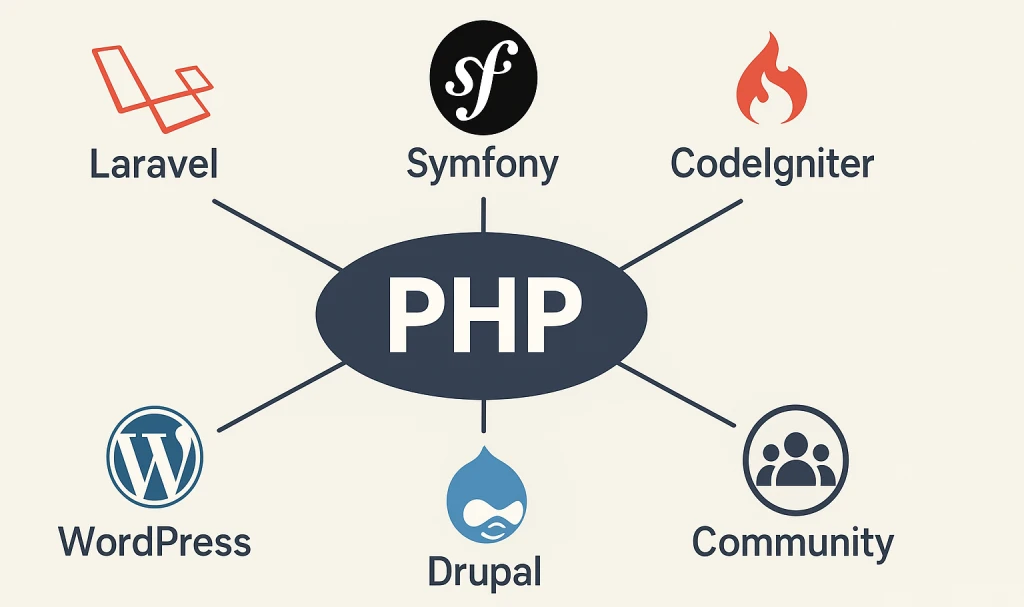
The PHP ecosystem includes several robust frameworks that cater to different development approaches:
Laravel: Known for elegant syntax and developer productivity
<?php
// Laravel Route example showing elegant syntax
Route::get('/posts/{post}', function (Post $post) {
return view('posts.show', compact('post'));
});
// Laravel Eloquent model with relationships
class User extends Model {
protected $fillable = ['name', 'email'];
public function posts() {
return $this->hasMany(Post::class);
}
public function getFullNameAttribute() {
return $this->first_name . ' ' . $this->last_name;
}
}
// Controller example
class PostController extends Controller {
public function index() {
$posts = Post::with('user')
->latest()
->paginate(10);
return view('posts.index', compact('posts'));
}
}
?>
Symfony: Focus on reusable components and enterprise features
WordPress: Powers over 40% of websites globally
The PHP ecosystem also includes comprehensive package management through Composer, which makes dependency management straightforward and reliable.
Python’s Growing Web Presence
Python’s web ecosystem, while newer than PHP’s, has grown rapidly and offers some of the most sophisticated web development tools available today.
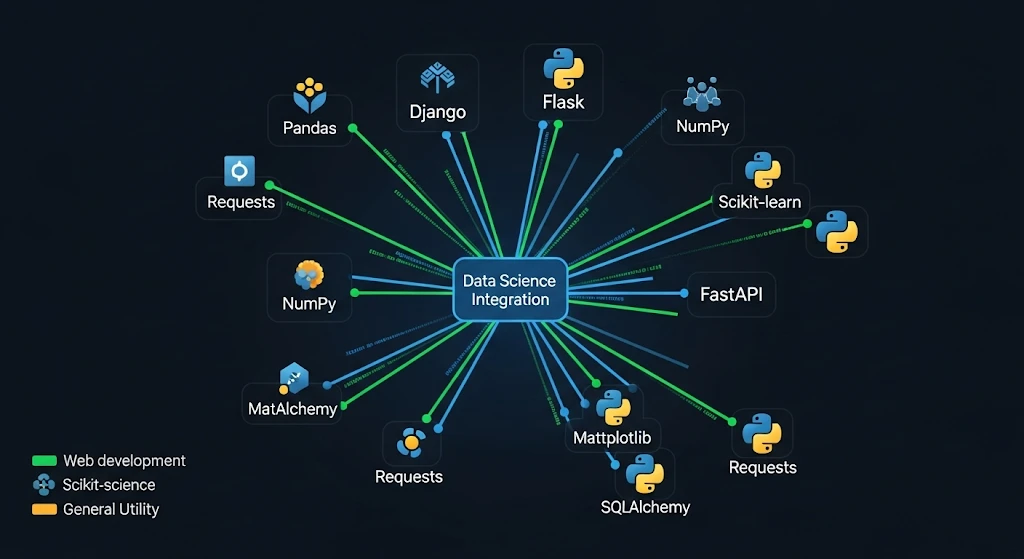
Django: The “batteries included” framework
# Django models with advanced features
from django.db import models
from django.contrib.auth.models import User
class Category(models.Model):
name = models.CharField(max_length=100)
slug = models.SlugField(unique=True)
def __str__(self):
return self.name
class Post(models.Model):
title = models.CharField(max_length=200)
slug = models.SlugField(unique=True)
content = models.TextField()
author = models.ForeignKey(User, on_delete=models.CASCADE)
categories = models.ManyToManyField(Category)
created_at = models.DateTimeField(auto_now_add=True)
class Meta:
ordering = ['-created_at']
def get_absolute_url(self):
return f'/posts/{self.slug}/'
# Django views with advanced features
from django.shortcuts import render, get_object_or_404
from django.core.paginator import Paginator
def post_list(request):
posts = Post.objects.select_related('author').prefetch_related('categories')
paginator = Paginator(posts, 10)
page_obj = paginator.get_page(request.GET.get('page'))
return render(request, 'posts/list.html', {'page_obj': page_obj})
Flask: Minimalist and flexible
from flask import Flask, render_template, request
from flask_sqlalchemy import SQLAlchemy
app = Flask(__name__)
db = SQLAlchemy(app)
class Post(db.Model):
id = db.Column(db.Integer, primary_key=True)
title = db.Column(db.String(200), nullable=False)
content = db.Column(db.Text, nullable=False)
def to_dict(self):
return {
'id': self.id,
'title': self.title,
'content': self.content
}
@app.route('/posts')
def posts():
page = request.args.get('page', 1, type=int)
posts = Post.query.paginate(
page=page,
per_page=10,
error_out=False
)
return render_template('posts.html', posts=posts)
Real-World Application Examples
PHP Success Stories
PHP powers some of the world’s largest and most visited websites. Understanding how PHP scales in real-world scenarios helps illustrate its practical capabilities.

E-commerce Platform Example:
<?php
class ShoppingCart {
private $items = [];
private $discounts = [];
public function addItem($product, $quantity = 1) {
$productId = $product->getId();
if (isset($this->items[$productId])) {
$this->items[$productId]['quantity'] += $quantity;
} else {
$this->items[$productId] = [
'product' => $product,
'quantity' => $quantity,
'price' => $product->getPrice()
];
}
return $this;
}
public function calculateTotal() {
$subtotal = 0;
foreach ($this->items as $item) {
$subtotal += $item['price'] * $item['quantity'];
}
$total = $subtotal;
foreach ($this->discounts as $discount) {
$total = $discount->apply($total);
}
return [
'subtotal' => $subtotal,
'total' => $total,
'savings' => $subtotal - $total
];
}
}
// Usage in a web context
session_start();
$cart = $_SESSION['cart'] ?? new ShoppingCart();
if ($_POST['action'] === 'add_to_cart') {
$product = Product::find($_POST['product_id']);
$cart->addItem($product, $_POST['quantity']);
$_SESSION['cart'] = $cart;
echo json_encode([
'success' => true,
'cart_total' => $cart->calculateTotal()
]);
}
?>
This example demonstrates how PHP naturally handles session management, form processing, and business logic in a way that’s immediately deployable to most web servers.
Python in Modern Web Applications
Python excels in applications that require complex data processing, integration with machine learning, or sophisticated business logic.
Data-Driven Web Application Example:
from django.shortcuts import render
from django.http import JsonResponse
import pandas as pd
import numpy as np
from sklearn.model_selection import train_test_split
from sklearn.linear_model import LinearRegression
class SalesAnalytics:
"""Advanced analytics for sales data using Python's data science libraries"""
def __init__(self, sales_data):
self.df = pd.DataFrame(sales_data)
self.model = LinearRegression()
self.is_trained = False
def prepare_data(self):
"""Clean and prepare data for analysis"""
# Handle missing values
self.df = self.df.fillna(self.df.mean())
# Create feature columns
self.df['month'] = pd.to_datetime(self.df['date']).dt.month
self.df['day_of_week'] = pd.to_datetime(self.df['date']).dt.dayofweek
return self.df
def train_forecasting_model(self):
"""Train machine learning model for sales forecasting"""
features = ['month', 'day_of_week', 'marketing_spend']
X = self.df[features]
y = self.df['sales']
X_train, X_test, y_train, y_test = train_test_split(X, y, test_size=0.2)
self.model.fit(X_train, y_train)
self.is_trained = True
return self.model.score(X_test, y_test)
def predict_sales(self, month, day_of_week, marketing_spend):
"""Predict sales based on input parameters"""
if not self.is_trained:
raise ValueError("Model must be trained first")
prediction = self.model.predict([[month, day_of_week, marketing_spend]])
return float(prediction[0])
# Django view integrating analytics
def sales_dashboard(request):
# Get sales data from database
sales_data = SalesRecord.objects.values(
'date', 'sales', 'marketing_spend'
)
# Initialize analytics
analytics = SalesAnalytics(list(sales_data))
analytics.prepare_data()
accuracy = analytics.train_forecasting_model()
# Generate predictions for next month
predictions = []
for day in range(1, 31):
pred = analytics.predict_sales(
month=request.GET.get('month', 12),
day_of_week=day % 7,
marketing_spend=1000
)
predictions.append({'day': day, 'predicted_sales': pred})
context = {
'model_accuracy': accuracy,
'predictions': predictions,
'sales_summary': analytics.df.describe().to_dict()
}
return render(request, 'analytics/dashboard.html', context)
This example showcases Python’s strength in combining web development with data science capabilities, something that would be much more complex to implement in PHP.
Making the Right Choice for Your Project
When PHP Makes Sense
PHP shines in several specific scenarios that align with its design philosophy and ecosystem strengths.
Traditional Web Applications: If you’re building content management systems, blogs, or traditional server-rendered websites, PHP’s immediate productivity and vast ecosystem make it an excellent choice.
Rapid Prototyping: When you need to get a web application running quickly, PHP’s ability to mix logic with presentation and its minimal setup requirements can speed up initial development significantly.
WordPress and CMS Development: If your project involves extending WordPress or working with other PHP-based content management systems, staying within the PHP ecosystem ensures compatibility and access to extensive documentation.
Budget-Conscious Projects: PHP hosting is widely available and often less expensive than specialized Python hosting solutions, making it attractive for projects with tight budget constraints.
Here’s a practical decision-making example:
<?php
// Quick prototype for a local business website
class BusinessWebsite {
public function getBusinessHours() {
$hours = [
'Monday' => '9:00 AM - 6:00 PM',
'Tuesday' => '9:00 AM - 6:00 PM',
'Wednesday' => '9:00 AM - 6:00 PM',
'Thursday' => '9:00 AM - 6:00 PM',
'Friday' => '9:00 AM - 6:00 PM',
'Saturday' => '10:00 AM - 4:00 PM',
'Sunday' => 'Closed'
];
return $hours;
}
public function isOpenNow() {
$currentDay = date('l');
$currentTime = date('H:i');
$hours = $this->getBusinessHours();
if ($hours[$currentDay] === 'Closed') {
return false;
}
// Simple time parsing for demonstration
$timeRange = $hours[$currentDay];
// In real implementation, you'd parse the time range properly
return true; // Simplified for example
}
}
// Immediate usage in HTML
$business = new BusinessWebsite();
?>
<!DOCTYPE html>
<html>
<body>
<h1>Welcome to Our Business</h1>
<?php if ($business->isOpenNow()): ?>
<div class="open-status" style="color: green;">We're Open!</div>
<?php else: ?>
<div class="open-status" style="color: red;">We're Closed</div>
<?php endif; ?>
<h2>Business Hours</h2>
<ul>
<?php foreach ($business->getBusinessHours() as $day => $hours): ?>
<li><strong><?php echo $day; ?>:</strong> <?php echo $hours; ?></li>
<?php endforeach; ?>
</ul>
</body>
</html>
When Python Is the Better Choice
Python becomes the preferred option when your project requirements extend beyond basic web functionality or when you need to integrate complex data processing and analysis.
Data-Heavy Applications: If your web application needs to process large datasets, perform statistical analysis, or integrate machine learning capabilities, Python’s extensive data science libraries make it the clear winner.
API-First Development: When building APIs that serve mobile applications or single-page applications, Python frameworks like FastAPI and Django REST Framework provide excellent tooling and performance.
Long-Term Maintenance: For projects that will require extensive maintenance and feature additions over time, Python’s clean syntax and testing culture often result in more maintainable codebases.
Integration Requirements: If you need to integrate with existing Python systems, scientific computing libraries, or data analysis pipelines, staying within the Python ecosystem reduces complexity.
Consider this example for a data-driven application:
from fastapi import FastAPI, HTTPException
from pydantic import BaseModel
import pandas as pd
import asyncio
from typing import List, Optional
app = FastAPI(title="Sales Analytics API")
class SalesRecord(BaseModel):
date: str
amount: float
customer_id: int
product_category: str
class AnalyticsResponse(BaseModel):
total_sales: float
average_sale: float
top_category: str
growth_rate: float
class SalesAnalyzer:
def __init__(self):
self.data = pd.DataFrame()
async def add_sales_data(self, records: List[SalesRecord]):
"""Add new sales data to the analyzer"""
df_new = pd.DataFrame([record.dict() for record in records])
df_new['date'] = pd.to_datetime(df_new['date'])
self.data = pd.concat([self.data, df_new], ignore_index=True)
async def get_analytics(self, start_date: str, end_date: str) -> AnalyticsResponse:
"""Generate comprehensive analytics for date range"""
if self.data.empty:
raise HTTPException(status_code=400, detail="No data available")
# Filter data by date range
mask = (self.data['date'] >= start_date) & (self.data['date'] <= end_date)
period_data = self.data.loc[mask]
if period_data.empty:
raise HTTPException(status_code=404, detail="No data found for specified period")
# Calculate metrics
total_sales = period_data['amount'].sum()
average_sale = period_data['amount'].mean()
top_category = period_data.groupby('product_category')['amount'].sum().idxmax()
# Calculate growth rate (simplified)
previous_period = self.data[self.data['date'] < start_date]
growth_rate = 0.0
if not previous_period.empty:
previous_avg = previous_period['amount'].mean()
current_avg = period_data['amount'].mean()
growth_rate = ((current_avg - previous_avg) / previous_avg) * 100
return AnalyticsResponse(
total_sales=float(total_sales),
average_sale=float(average_sale),
top_category=top_category,
growth_rate=float(growth_rate)
)
# Global analyzer instance
analyzer = SalesAnalyzer()
@app.post("/sales/", response_model=dict)
async def add_sales(records: List[SalesRecord]):
await analyzer.add_sales_data(records)
return {"message": f"Added {len(records)} sales records"}
@app.get("/analytics/", response_model=AnalyticsResponse)
async def get_analytics(start_date: str, end_date: str):
return await analyzer.get_analytics(start_date, end_date)
if __name__ == "__main__":
import uvicorn
uvicorn.run(app, host="0.0.0.0", port=8000)
This Python example demonstrates sophisticated data processing, automatic API documentation, and type safety that would be significantly more complex to implement in PHP.
Practical Decision Framework
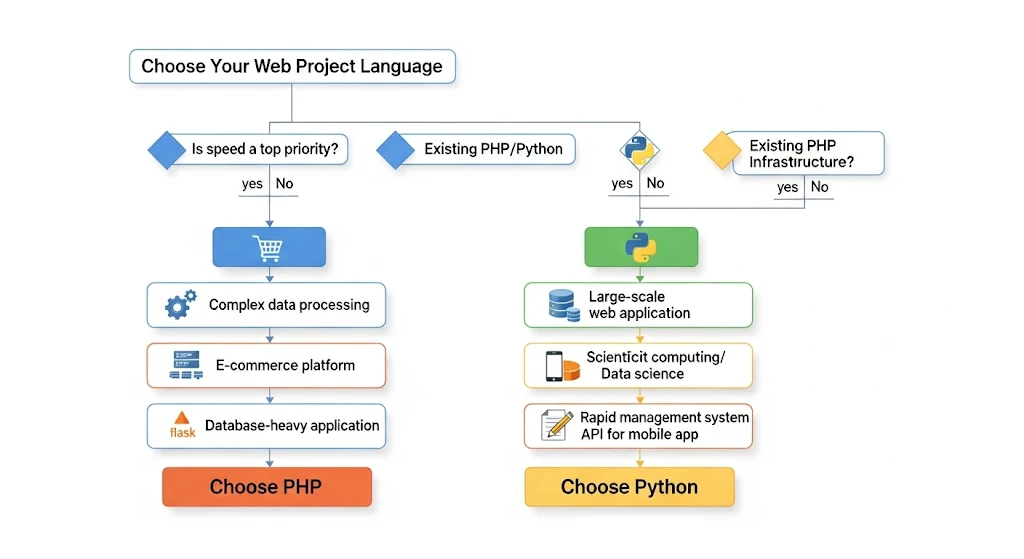
When making your decision, consider these key factors in order of importance for your specific situation:
Project Complexity and Scope: Simple websites and content management systems often benefit from PHP’s straightforward approach, while complex applications with data processing needs typically favor Python’s architectural strengths.
Team Expertise and Learning Goals: Consider your team’s current skills and their desire to learn new technologies. PHP might offer a shorter path to productivity, while Python might align better with long-term career development goals.
Performance Requirements: Both languages can handle high-traffic applications, but their optimization strategies differ. PHP excels at handling many simple requests, while Python shines in applications requiring complex processing per request.
Integration Needs: Consider what other systems your application needs to connect with. PHP integrates naturally with traditional web hosting and WordPress ecosystems, while Python connects seamlessly with data science, machine learning, and modern API architectures.
Long-Term Maintenance: Think about who will maintain the application over time. Python’s emphasis on readable code and testing often results in more maintainable applications, while PHP’s direct approach can be easier for junior developers to understand initially.
The choice between PHP and Python isn’t about finding the objectively “better” language, but rather about selecting the tool that best matches your project requirements, team capabilities, and long-term goals. Both languages have powered successful applications at massive scale, and both continue to evolve and improve.
Understanding these nuances helps you make an informed decision that serves not just your immediate development needs, but also your project’s long-term success and maintainability. Whether you choose PHP’s pragmatic web-first approach or Python’s versatile, analysis-friendly ecosystem, success ultimately depends on how well the chosen tool aligns with your specific requirements and team strengths.


